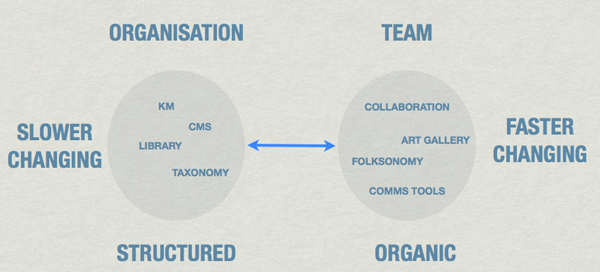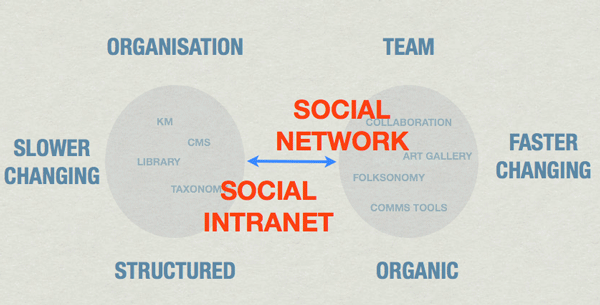Of late I’ve been reading quite a few posts on how we might depict the social intranet. Two in particular I am going to focus on here and they are from Jane McDonnel and from Deb Lavoy. Let’s start with Jane’s post “To technology strategists: how to blend enterprise + business + people?”. Here Jane argues that the workplace has 3 perspectives and to each she ascribes 3 collaborative tools by asking the salient question, of which will meet the differing needs of each of these 3 organisational elements.:
- The Enterprise : Content Management System (CMS, central, guidelines & Governance)
- The Business : Collaborative Software (Team Based, IT provided)
- The Individual : Social Network (Profile based, Evangelist driven)
Jane rightly argues that there are different entry points here and they require different governance. She did seem to point to the individual network driven aspect being in some way created by the individual, I could not see how that would work unless the network was of sufficient scale to create a network, which implies a more collaborative scope. Maybe on this we have the more central Enterprise capability and then the Collaborative sphere that includes the Business and the Individual.
Now when Deb comes to work on this knotty problem she also defines a triple organisational breakdown (with the caveat that they’re obliquely defined) and correlates to these, 3 forms of collaboration:
- Team : Creative Collaboration> Process driven, Communication, Organisation, team based
- Community : Connective Collaboration> Serendipity driven, looser ties, ‘expert locator’, network based
- Organisation : Compounding Collaboration> Leveraging the already done, Knowledge Management+
What I thought of note here (& not to miss also a fabulous definition of the Intranet), is that like Jane, Deb describes two aspects to these spaces/activities and argues that we have the social intranet sphere, which is enterprise based and the collaborational space which is more team-based. Deb argues that no one set of tools can meet the needs of both.
So if we take a deep breath here, we can see in both descriptions that we have (not withstanding our dire need of new terms):
Enterprise : CMS, KM: Enterprise Social Network platform.
Business/Teams/Communities : Social Networks, Collaboration Tools
or as Deb puts it:
“It’s no longer about social intranet vs. collaboration, but organizational enablement vs. team enablement.”
Now at this point, I take a dialectical step backwards and argue that there’s a productive engagement in this contest of needs, that they are mutually dependent, that it’s not a question of ‘Or’, but ‘And’. I would like to structure this as the more formally structured and slower changing Enterprise and along side it the less formally structured and more organic, faster changing, area of the Team and collaboration. One is organised as a Library might be, it is Taxonomic, the other more Creative, it is Folksonomic and structures itself in ways more akin to the Library.
I have tried to represent these ideas as so (they’re a little more 3D in my mind and a lot less static) :
There’s something missing here and which without it, the 2 digital spheres could, perhaps would remain completely disconnected. And that I would argue is the Network, with its prime modus being the Connectedness between People to People and the Intranet, with its prime modus being the Connectedness between People and Data. Thus we have something looking more like this:
On this I would argue that we need the social cohesiveness and connectivity to make that, and this being the Holy Grail of KM, to make that Data, Knowledge. But we also have other interesting things happening here, we have in organisations without a full social suite of capabilities, teams and people using collaborative technologies – digital phones both mobile and fixed; webinars and conferencing; and of course any other tool they might shadowly bring into work. These in themselves create drivers for connecting up the individual collaborations and making them more social. They also create expectations too.
But more importantly, we can see the business need, almost imperative to introduce some means of connecting up the parts. What’s needed is a way of connecting up the more formal Enterprise structure with the rest of the Business. A traditional 1.0 intranet won’t do that, it will be forever a static portal onto the silos of data in the management systems.
And then comes the rub. We have on the one had the collaboration tools, the Cisco WebEx and Microsoft Communicators for example, as well as the usual 2.0 tools at play. We have a more social intranet, possible overlapping and interloping into the collaboration space and vice versa. The questions then becomes thus:
Should the more structured Enterprise be integrated into the Collaboration space (and vice versa)?
If so, how can this be achieved without in doing so, creating a Social Business?
Refs
Is Social Intranet a Collaboration Solution?
To technology strategists: how to blend enterprise + business + people?
Scaling the Enterprise Social Network Pyramid


